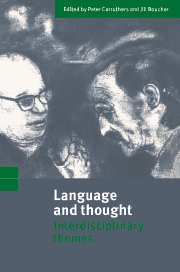1 - Introduction: opening up options
Published online by Cambridge University Press: 08 January 2010
Summary
The basic dichotomy
What is the place of natural language in human cognition and thought? People's views on this matter have differed very markedly, dividing roughly into two opposing camps, as follows. (We shall shortly muddy these waters somewhat, by suggesting the possibility of a variety of intermediate positions. But we begin with a clean dichotomy, as an aid to the reader's vision.) On the one hand, there are those who espouse what we shall call the communicative conception of language, who view language as a mere adjunct to belief and thought. As the name suggests, they see the exclusive function and purpose of language to be the communication of thought, where thought itself is largely independent of the means of its transmission from mind to mind. The communicative conception is now dominant in many areas of the cognitive sciences (understood broadly to include cognitive psychology, empirical-minded philosophy of mind, linguistics, artificial intelligence – AI – and cognitive neuroscience), for reasons which we shall soon begin to explore. However, equally many historically have been committed to what we shall call the cognitive conception of language, which sees language as crucially implicated in human thinking. Roughly speaking, on this view, we think in natural language, in such a way that natural language sentences are the vehicles of our thoughts. Those espousing the cognitive conception have not claimed that language is used exclusively for thought, of course; they have allowed that it is also used in communication (they could hardly do otherwise).
- Type
- Chapter
- Information
- Language and ThoughtInterdisciplinary Themes, pp. 1 - 18Publisher: Cambridge University PressPrint publication year: 1998
- 18
- Cited by

